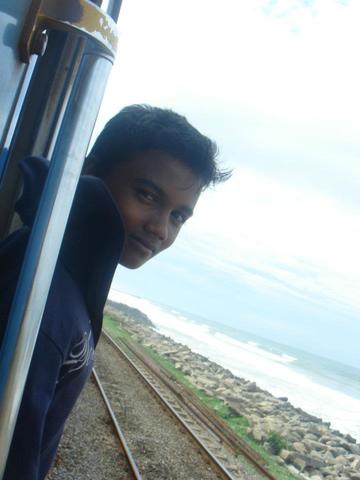Train
Though covering only a limited proportion of the island, the train network in Sri Lanka provides in many senses the best way to travel. They are safer and more comfortable than buses and two of the routes are amongst the world’s most classic rail journeys.
There are three major lines: the first, the coast line, runs from Matara in the far south around the west coast through Galle and Colombo, finally ending up to Puttalam (sadly it doesn't go as far as Jaffna in the north-west.) The hill country line runs from Colombo, through Kandy and then onto Ella and Badulla. Finally, the northern line runs north inland through Kurunegala and Anuradhapura and currently terminates in Omanthai (it is being extended, slowly, to Jaffna.)
Trains are usually divided into second- and third-class carriages. There’s not a world of difference between the two, with slightly more legroom and more cushioned seats on the former. The hill country line provides a first-class service with airline style seats and a meal included - worth thinking about if you’re taking the mammoth 12 hour trip to Ella or Badulla. This line also has a sleeper service. It’s bookable in advance.
Most foreigners find train tickets in Sri Lanka to be extremely cheap - you can go anywhere in the country for under 5 US dollars, and most journeys will cost half that. The best place for rail enquiries is Colombo’s main railway station at Fort - though the ticket queues can descend into a real scrum if you arrive at the wrong time.
You can check train timetables online at railway.gov.lk along with gic.gov.lk (although these might be out of date in certain cases).
Bus
Buses are the cheapest and most popular form of transport in Sri Lanka. They are noisy, smelly and often drive at very alarming speeds.
As a general rule, there are two types of bus in Sri Lanka: monstrous 50-seaters that race along at ungodly speeds and smaller (though not usually less cramped) minibuses. The latter will usually have air-conditioning. Chances are you will end up taking at least one of these during your time in Sri Lanka. They tend to be privately owned (apart from the red SLTB buses) by a driver and conductor who will set their own prices (these will usually seem incredibly cheap to foreigners).
Be prepared for a lot of stops - buses will take on and let off passengers wherever a request is made. This, combined with the packed, uncomfortable conditions and blaring Sinhalese pop music can make for a frustrating journey. Finding the right bus can also be challenging - signage is very often in Sinhala only (though increasingly bilingual with Tamil on state-run buses) so it’s usually worth asking the driver or conductor where he’s going. Take care getting off - drivers will often only slow down enough for you to take a running jump rather than stopping completely.
Bus travel to the southern cities of Galle and Matara is now a much more attractive prospect following the completion of the Southern Expressway. This means you can arrive in half the time it took previously - plus the service is fully air conditioned. On the negative side, the fare is much more expensive, and buses only leave from Maharagama - at least 45 minutes tuktuk journey south of Colombo’s centre.
The Pettah Bus Stand is Colombo’s main bus hub.

Plane
Sri Lankan Airlines offer an internal sea-plane service which uses lagoons and wewas to land near Trincomalee, Ampara, Arugam Bay, Tissamaharama, Hambantota, Dikwella, Koggala, Bentota, Kandy, Nuwara Eliya and Dambulla - leaving from and returning to Colombo. It’s pricey though.
Helitours, the commercial arm of the Sri Lankan Air Force also fly internally, including to Jaffna. Their aircraft are mostly small prop planes and depart from Ratmalana air base in Colombo.
Car
There are two options for getting around by car in Sri Lanka: renting a driver with his own vehicle, or hiring your own. It’s preferable to choose the former option for a number of reasons.
Firstly, driving in Sri Lanka is dangerous unless you know the roads well. Apart from the state of many of the roads themselves (think potholes and dirt tracks), drivers, especially the ubiquitous bus drivers, can be aggressive and unruly. High-speed overtaking on sharp bends is the norm.
Aside from this, you’ve got to watch out for wandering stray dogs whose regard for high-speed traffic is often non-existent.
Reliable car-hire firms include Malkey’s (http://www.malkey.lk/ ), Europcar (http://www.europcar.lk/ ) and Quickshaws (http://quickshaws.com/ ). All three are based in Colombo
Hiring a driver
If the idea driving in Sri Lanka doesn’t appeal to you, it’s often just as cheap to hire an experienced Sri Lankan driver with his own vehicle. Naturally, prices tend to depend on the size and quality of the vehicle, as well as the experience of the driver. If you’re looking for a more comfortable way to travel long-distance without breaking the bank, this is it.
Recommended drivers include:
Dimantha Dasun Thilaka (dimtours.com ; ) and Sudath Gunaratne ().
Buying a Car in Sri Lanka
If you’re brave enough to commit to driving in the long term, you will need an international driving licence which will give you access to the additional documentation you need to drive on the island. This can be obtained from the Automobile Association of Ceylon found next to the Ramada Hotel in Colombo.
Most expats decide not to buy a car, as they are all imported to the island and have huge duties put on them making them unaffordable, even for most foreigners. If you decide to buy, the next step is to secure at least third-party motor insurance (this is the bare minimum required to drive your own car).
Tuktuk/Three-wheeler
If you’re going a short distance, especially within a city, tuktuks will easily be the most economical option. Your best bet is simply to go out into the street and hail one - you won’t need to wait long.
Make sure your driver uses a meter (most tuktuks have them now, especially in Colombo. You might have to negotiate a price with your driver in other parts of the country.) Once in the vehicle, keep an eye on the meter as they can be rigged to count up faster, conning you out of your cash.
Taxis
Taxis are available, but need to be booked by phone and cost significantly more. However, you get better security and your driver is much more likely to know where he’s going. Kangaroo cabs, primarily based in Colombo, are recommended (Tel. 0112 588 588)


